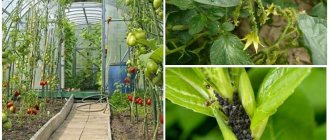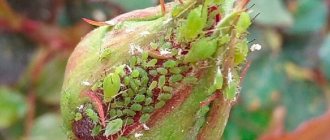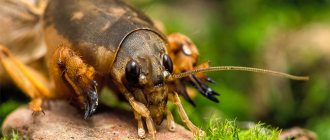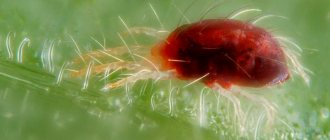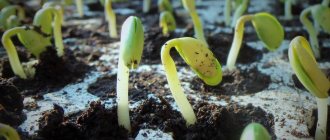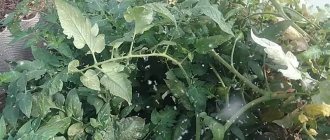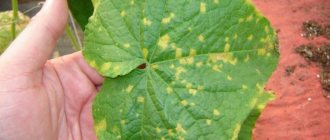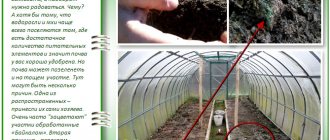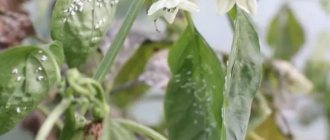A greenhouse is a great way to taste aromatic cucumbers, tomatoes, and peppers in early spring. Complex open-ground crops, such as eggplants, are planted there. Aphids in a greenhouse become a real disaster. In a confined space, plants simply don't stand a chance. You need to be prepared for this and know how to get rid of aphids and how to deal with them correctly.
Aphids in the greenhouse: description of the pest
Melon aphids are small sucking insects of light yellow, green or black color ranging from 1.5 to 2.1 mm in size. They appear in greenhouses and greenhouses in May, attacking fresh vines of cucumbers and other crops. Colonies of pests stick to the back of leaves, young shoots and flowers. With severe damage, the leaves dry out, the plants wither and gradually die.
Aphids, adults, larvae and winged females
In greenhouse conditions, melon aphids reproduce quickly; they can produce up to 20 generations per season. If the fight is not started in time, it will fill the entire greenhouse and the crop will die. In addition to cucumbers, aphids can settle on other crops: tomatoes, eggplants, peppers and beans, and in some cases also on dill and carrots.
Aphids are dangerous not only because they suck juices from plants. The sticky secretions create a favorable environment for the development of fungus; in addition, the sweet coating disrupts plant respiration and photosynthesis. Adult aphids are capable of carrying more than 50 bacterial and viral diseases, the treatment of which will require disinfection of the greenhouse and replacement of the soil.
Fighting aphids
Identifying aphids is quite simple: the attached insects at first look like numerous pimples on the leaves and stems. Upon closer inspection, you can see not only adult individuals, but also larvae - smaller and almost colorless. Female aphids are viviparous; the development of the larvae takes no more than two weeks, after which the young individuals become capable of reproduction.
When the colony grows, winged individuals appear among the female aphids, capable of flying to other plants. Such females are distinguished by a darker body color and a pair of light long wings. In this phase of development of a pest colony, it is necessary to take urgent measures to destroy them immediately, otherwise the insects will completely colonize the area.
Life cycle of aphids
Garden ants play a major role in the spread of aphids throughout the garden. They feed on the sweet sticky juice secreted by adult aphids and take care of their “cash cows”: they transfer them to new plants and also shelter them in an anthill for overwintering. Therefore, the fight against aphids necessarily includes measures to get rid of ants.
Ants spread aphids
Greenhouse
In greenhouse conditions, several different forms of greenhouse aphids can exist simultaneously. Otherwise it is called green peach, because this particular crop is its primary host. But there is no need to have any illusions - the greenhouse aphid is omnivorous, like most of its relatives. Cucumbers, tomatoes, fresh salads or greens will be used.
In a greenhouse, a colony of aphids reproduces up to 14 times a year. The maximum size is 2.5 mm. They come with and without wings, green, black and black-green. If the damage has reached 25% of the leaves, then obtaining cucumbers, peppers or tomatoes is a big question. Develops from +10°C.
Types of aphids and how they attack plants
Aphids are insect pests that reproduce by oviparity. Aphids can be winged or wingless. The insects are very small - ranging in size from 2 to 8 millimeters. Aphids have small proboscis, with the help of which they “suck” useful substances and juice from the plant; moreover, aphids are carriers of infectious plant diseases.
"Fitoferm" is absolutely safe for plants in a greenhouse, but is effective against aphids.
- Melon aphid. This is a species of aphid that mainly affects pumpkin crops, zucchini and cucumbers. Aphids appear, as a rule, at the tips of the leaves, spreading in the direction of the leaf, towards the stem. The leaves of the plant curl and disappear, and the inflorescences fall off. The melon aphid is dangerous because it does not die in the winter, but successfully overwinters until the next harvest on dry grass, weeds and fallen leaves. In one year of life, the melon aphid is capable of breeding about 20 generations of insects. The melon aphid is “afraid” of tomatoes. Aphids practically do not exist on the leaves and ovaries of this plant.
- Greenhouse aphid (green peach). This insect attacks many types of plants: eggplant, parsley, dill, tomatoes, peppers, cucumbers and potatoes. In addition, greenhouse aphids are carriers of viral plant diseases. Pests feed on the sap of the leaves, so the leaves deteriorate and turn yellow. Insects can infect plants with more than 100 viruses.
- Potato aphid (common). Aphids are dark in color, ranging from blue to gray. This type of aphid mainly affects tomatoes. Breeds all year round. Aphids feed on leaf sap. In the autumn-winter period, insects live on the remains of grass and plants, and in the hot summer period they are able to leave greenhouses in whole colonies.
- Large potato aphid. A favorable climate for insects is an increased level of humidity in the ground and air. Aphids infect plants in entire colonies. Potatoes and cabbage suffer greatly, as well as tomatoes, peppers, and eggplants. Aphids are located on the lower part of the leaves and feed on plant sap. Dark spots first appear on the plant, and only then the leaves curl and turn yellow, but aphids are not noticeable on the leaves.
Greenhouse conditions are a favorable place for the reproduction and life of insect pests that can completely destroy the crop. Therefore, it is worth choosing effective methods for pest control.
The fact that greenhouse crops have already been favored by a colony of aphids can be easily seen from the state of the plants:
- leaves begin to dry out and curl;
- small white insects sit on the back of the leaf;
- there are sticky marks on the leaves on top;
- the growth of shoots stops, and their tips become bent;
- the ovary freezes without opening its buds.
Aphids can appear at any stage of growing greenhouse plants, so treating the greenhouse does not always help. Having the ability to fly, insects can get inside when ventilated. They can also be “brought in” along with soil, seedlings or organic fertilizers.
Signs of presence and the importance of timely detection
In a greenhouse, aphids can remain undetected for quite a long time. Pests prefer to live on the underside of leaf blades, from which they suck the juices. The leaves begin to curl, the shoots become shortened and deformed. The flower stalks are bent, the concretes fall off without blooming.
Without timely control, aphids in a greenhouse multiply very quickly and can cause significant damage to plantings and significantly reduce the yield.
The formula for the fight is simple: the sooner you find the enemy on your territory, the faster and easier it will be to get rid of him.
Sign of the presence of parasites
Traditional recipes for fighting aphids
Fighting aphids is always painstaking work for farmers, because colonies of pests populate almost the entire area of the plant. But since ancient times, our great-grandfathers have known golden recipes.
We invite you to familiarize yourself with Spring mushrooms: morels and stitches. Edible or poisonous?!
A solution of onion scales will help get rid of aphids in one go. 20 grams of onion scales are boiled in water, then left for 7-10 hours in a dark place. Strain and spray the plants affected by aphids. This method can be used repeatedly, from sowing to harvest. Aphids die 60% of the first treatment and 100% of the next.
Spraying plants and soil with celandine infusion will help get rid of aphids.
Crushed 400 g of dandelion root, infused for 6 hours in 10 liters of water in a dark place, helps get rid of aphids without the use of chemical compounds. Aphids die by 80%.
Tobacco and shag are poured with boiling water in the proportion of 50 g of raw material per 5 liters of water, left for 3 hours and sprayed on the plants. The effect after treatment is observed after 7 hours. Aphids die by 90%. The products are ready to eat after 7 hours.
Celandine is widely known to combat aphids. It is used both in a spray solution and in the form of dry brooms suspended in a greenhouse or spread between rows. To prepare a solution for spraying, you need to take 500 g of grass, chop it and pour 2 liters of boiling water. Let sit for at least 4 hours.
Strain and spray the plants, watering 300 g per bush from above. For brooms, in order to destroy aphids, you need to tie 10-15 branches of flowering celandine into a bunch and lay them between the rows every 2-2.5 meters. The aphids are completely killed by 80-90%. This is an environmentally friendly method of controlling greenhouse pests.
Use of chemicals
There are aphids on cabbage, flowers, fruit trees or other plants; these products will help get rid of them within 1-2 days. The most effective of them are:
Chemicals based on imidacloprid or thiamethoxam. This group of products includes Iskra Zolotaya, Tanrek, Konfidor, Aktara. These drugs cause virtually no harm to the human body, but they protect culture tissues from the inside, penetrating deeply into them. They are often used through irrigation systems for plants growing in greenhouse conditions. They are highly effective, and their only drawback is their relatively high cost; Another group of chemicals are products based on permethrin compounds. This group includes such drugs as “Inta-Vir”, “Decis Profi”, “Kinmiks”. Their peculiarity is that they achieve results very quickly - sometimes just a few minutes are enough. In plant tissues, their components do not accumulate, remaining on their surface, and within 2 weeks they disappear from it. With them their effect disappears
Whether you are deciding how to get rid of aphids on roses or cucumbers, other flowers, vegetables, or fruit trees, use these products with great caution, because they can leave burns on young plants, which stops their development. Care must be taken when working with them also because such drugs can irritate the mucous membranes and human skin
According to the criterion of the impact on the body of the latter, they are classified as means of an average level of toxicity; Preparations containing organophosphorus compounds. Representatives of this category are “Fufanon”, “Alatar”, “Karbofos”, “Aktellik”. Such products have recently been used less and less, since they are characterized by high toxicity to humans and the environment, and their effectiveness in matters of how to get rid of aphids on cucumbers, other vegetables, flowers, fruits, and ornamental crops is insufficient. This is especially true for insect populations emerging in recent years.
Even the most powerful chemicals should not be used frequently. On the packaging they are always given instructions for their use, which must be strictly followed. Before processing, be sure to wear a respirator, safety glasses, gloves, and special clothing.
Prevention of aphids
The appearance of pests in a greenhouse can be prevented by regular treatment of the soil and structures. Prevention includes a whole range of measures.
Greenhouse disinfection
Traditionally, the greenhouse is disinfected in the fall after the end of the season. Solutions for preventive treatment of greenhouses, as well as methods for their preparation and processing are given in Table 1.
Table 1. Solutions for preventive treatment of greenhouses.
| Name, illustrations | Description how to use |
| Copper sulfate | The powder is blue or turquoise in color; when diluted, it produces a solution of copper sulfate, which kills pest larvae, as well as fungal infections. Preparation of the solution: 1 tablespoon of powder is diluted in a liter of hot water, stirred thoroughly and brought to 10 liters with cold water. Water the soil with the solution until the top five-centimeter layer is moistened, and also spray the walls of the greenhouse and the fences of the beds. |
| Bordeaux mixture | It is a mixture of quicklime and copper sulfate, used for cultivating soil and greenhouse structures. Preparation of the solution: 100 g of copper sulfate powder is diluted in a liter of hot water, brought to 5 liters with cold water. In a separate bowl, quench 120 g of lime, after which the milk of lime is diluted with water to 5 liters. Carefully pour the vitriol into the lime solution with constant stirring. The solution is used immediately. The walls and frame of the greenhouse and the top layer of soil are treated from pests and bacteria. |
| Bleaching powder | The finished powder is white in color with a sharp, specific odor. Destroys adult aphids and larvae. The powder is scattered over the surface of the soil, after which the top layer is loosened to a depth of 5-8 cm. |
| Karbofos or fufanon | A chemical substance in the form of a solution is used to treat the soil to kill pests. Dilute a solution of karbofos (30 g per 10 liters) or fufanon (10 ml per 10 liters) in cold water, water the soil until moist. |
Fighting ants
Ants often settle in greenhouses; this is facilitated by early warming of the soil and stable temperature. Ants grow aphids for their sweet juice (honeydew), for which they spread them to plants. It is pointless to remove aphids without destroying anthills - ants will quickly populate new larvae in place of destroyed insects.
https://www.youtube.com/watch?v=bK3LuRyh_b0
Ants are fought using special means or traditional methods.
- The Anteater product is used to kill ants in the form of a solution that is used to water anthills. A 1 ml bottle of the drug is diluted in 3-5 liters of water and watered anthills in the morning or evening, when the ants are in the shelter. Within 2-3 days, the entire population of the anthill dies.
Ant-eater
anteater remedy
- The product “Grom-2” in the form of granules is scattered over the surface of the anthill, having first removed the top layer of it by 2-3 cm. The removed soil is scattered on top of the preparation. Within 2-4 days the ants die, the effect of the product lasts up to 2 months.
- Sprinkle anthills with ash, lime or baking soda, followed by watering with hot water. Penetrating into the passages, water with an alkaline reaction has a destructive effect on ant larvae and adults.
- Digging anthills to a depth of 25-35 cm allows you to completely destroy the nest. It is performed before planting cucumbers in the greenhouse and preparing the beds. Larvae and ants are scalded with boiling water when digging.
- Plants with a pungent odor are laid out on the beds - garlic, mint, oregano, valerian. They scare away the ants and force them to leave the greenhouse.
- all plant residues and debris are removed from the site and then burned;
- around all plantings it is necessary to destroy weeds on which garden and vegetable pests can multiply;
- plants that may be attractive to aphids are best planted away from nasturtium, poppy, mallow, viburnum, linden;
- It is necessary to inspect the plants weekly for the appearance of small insects;
- Dead yellow leaves should be removed in a timely manner so that aphids do not spread to surrounding leaves;
- the plants must have access to air so that the shoots are not weak, which can lead to the development of aphids;
- To increase the resistance of plants to pests, the timing of sowing and planting, the optimal temperature regime (at night 18-20 ° C, during the day not higher than 28 ° C), air humidity (75-80% during the day, 85-90% at night), fertilization should be observed. ;
- plants must be watered with warm water, not higher than 25°C;
- When it gets cold, you should not over-moisten the soil.
Grom-2
The found anthill should be covered with ash, lime or ash.
Digging up an anthill
Valerian
Oregano
Mint
Garlic We invite you to familiarize yourself with the LED phytolight Chiston-S? ? buy in the Belaya Alley online store
To prevent the appearance of aphids, you can treat young plants with one of the biological products, for example, Fitoverm. This product does not have a harmful effect on plants or soil bacteria, and its waiting period is 2 days, after which its fruits can be eaten. Fitoverm can be used to treat plants in any phase of growth and fruiting.
Fitoverm
Dilute the drug in a dosage of 1 ampoule per 1.2 liters of water and spray the plants in the morning or evening until the leaves are moistened. Spraying for preventive purposes is sufficient to carry out once every 15-20 days, starting from planting until mid-July. During the summer period, 3 treatments are usually carried out.
fitoverm
Timely and proper care of plants in the greenhouse will ensure the development of healthy shoots and a full harvest.
Preventive measures to prevent the appearance of various pests in the greenhouse include watering the plants with warm water, approximately 23-25 ° C.
After sealing the greenhouse, at the end of the growing season, to destroy pests, it is necessary to disinfect the plants with a mixture of insectoacaricide and 40% formaldehyde.
For preventive purposes, racks, paths, equipment, and containers in the greenhouse should be disinfected with bleach. To do this, 400 g of bleach must be diluted in 10 liters of water, left for 2-4 hours, then the drained liquid must be used for spraying, and the resulting lime deposit should be coated with the entire greenhouse. You can also use caustic soda for this, at the rate of 300-500 g per 10 liters of water.
If there are a lot of pests, it is better to use special preparations. Unlike folk remedies, they act faster. But there is also a negative point: such treatments are carried out mainly before fruiting begins. Chemicals tend to accumulate in fruits.
The frequency of treatment depends on the specific product. Therefore, before use, be sure to carefully study the instructions.
Folk and industrial remedies help get rid of greenhouse pests, but do not forget about aphid prevention measures, namely:
- thoroughly clean the soil in the greenhouse from plant remains, rhizomes, and leaves before planting and after harvesting;
- fertilize the soil with organic matter;
- carry out examination of plants for the presence of aphids;
- Do not propagate flowers together with vegetables in a greenhouse.
By following the rules and advice of experts in the fight against aphids, you can get a generous greenhouse harvest.
Preventive measures
In the confined space of a greenhouse, it is worth carrying out comprehensive work to prevent the development of pests and diseases. After harvesting, it is necessary to disinfect the structure itself, tools and soil in the greenhouse.
Processing the greenhouse and equipment in the fall
Treatment of the greenhouse after harvesting consists of washing the structure and disinfecting it. Metal parts and windows can be washed with soapy water or bleach. Fumigation with a sulfur bomb is perfect for disinfection.
The procedure for treating a greenhouse in the fall with a saber is as follows:
- The first step is to ensure the integrity of the coating of the metal parts. If the enamel has chips or cracks, they must be primed and painted over. If this is not possible, cover with a thick layer of grease to prevent corrosion.
- It is necessary to make sure that all windows and doors close tightly, there are no cracks or holes, so that the gas does not evaporate in vain.
- A non-combustible base (brick, metal basin) is placed on the ground in the center of the greenhouse, and a checker is placed in it. The checker is set on fire.
- Next, you need to leave the greenhouse as quickly as possible, closing the door tightly.
Tilling the land in autumn
Soil treatment is carried out in several stages.
- All plant residues, wooden pegs, and strings are removed and burned so that pests do not hide in them for the winter.
- The earth is being dug up.
- Then the soil is disinfected. To do this, the ground can be watered with a solution of copper sulfate or Bordeaux mixture.
- If the design of the greenhouse allows, you can leave a window or door open for the winter. The soil will freeze, the pests and eggs that remain in it will die.
Advice! To further freeze the soil in the greenhouse in winter, you can throw a 20-30 cm layer of snow on the beds and leave it until spring. Melted snow will additionally moisten the soil with the arrival of warmth.
Agrotechnical methods of combating aphids
Agrotechnical methods involve strengthening plant immunity and using environmentally friendly pest control methods. The effectiveness of these methods is quite high, especially if they are used in combination.
Types of aphids and their biological enemies: 1 - Aphid, 2 - Coniferous aphid, 3 - Phylloxera aphid, 4 - Apple aphid, 5 - Lacewing, 6 - Hemerobia, 8 - Decorated spherophoria, 9 - Bandaged sirph, 10 - Hoverfly , 11,12,13 - Cows, 14 - Orius bug, 15 - Zikrona bug, 16,17 - Aphelinus ichneumon
Adult aphids and larvae are happily eaten by predatory insects, and by attracting them to your greenhouse, you can reduce the number of pests without harming the plants.
Biological enemies of aphids include:
- ladybugs and their larvae;
- hover flies;
- earwigs;
- lacewings;
- predatory wasps;
- small birds - sparrows, tits and warblers.
Ladybugs can be carefully collected from the garden or meadow and released into the greenhouse. They will take root and begin to lay larvae, which are unusually voracious: one ladybug larva can destroy up to a hundred aphids per day.
Ladybug destroys aphids
To attract predatory insects - hoverflies, lacewings and wasps - experienced gardeners recommend planting aromatic herbs along the beds in the greenhouse: dill, parsley, fennel and cilantro.
Common lacewing
Hoverfly
Earwigs feed on aphid larvae. They prefer warm and humid places as shelters; for this, you can pour piles of sawdust or bark in the greenhouse and pour water on them.
Earwig
Birds eat winged aphids and prevent them from spreading throughout the garden. To attract birds to the greenhouse, you can hang feeders and place drinkers in advance, at the beginning of the season, so that the birds get used to it.
Sparrow
The melon aphid prefers to feed on young plants with tender leaves. This is the basis of the agrotechnical method of combating aphids by planting bait plants. As such plants, you can use beans, dill, as well as cucumber seedlings that are younger than the main plantings. Plants are planted along the ridges, and when pests appear, they are torn off and burned along with aphids.
Dill is planted along the cucumbers
Some weeds also attract aphids. These herbs include all types of thistle. It is enough to leave one or two sow thistle bushes near the cucumbers in the greenhouse, and a significant part of the aphids will end up on them. Infected parts of the plant are torn off along with the pests and destroyed. Thistle is good because it does not take away nutrients from plants, since its root goes to a considerable depth and takes nutrition from there, while the root system of the cucumber lies in the top layer of soil.
Bait plant - sow thistle
Planting repellent plants, the smell of which aphids cannot stand, also has some effect.
We suggest you read: How to choose tasty and healthy strawberries
These include:
- mustard;
- cilantro;
- mint;
- basil;
- marigold.
They are sown along the edges of cucumber beds or planted near the entrance. Mint also repels ants that spread aphids. Basil and marigolds repel, in addition to aphids, many other pests, including nematodes.
Marigolds repel aphids
Another agrotechnical method to reduce the harmful effects of aphids on plants is strengthening the immune system. To do this, it is important to use healthy planting material, apply fertilizers on time and properly prepare the soil.
The temperature regime in the greenhouse also promotes the growth of healthy cucumbers: during the day the temperature should be within 25-30°C, at night – 15-18°C. An increase or decrease in temperature from these limits weakens the plants and they become susceptible to infection by infections carried by aphids.
Proper watering is of great importance. For it, it is necessary to use soft water with a temperature of about 25°C, and also maintain the humidity in the greenhouse within 70-80%. As a preventative measure, in the first half of summer you can use an infusion of nettle or tomato tops for watering. In addition to the repellent effect, this infusion enriches the soil with easily digestible nitrogen, which benefits cucumbers. Foliar feeding with complex fertilizer for melons and melons is also useful.
Watering cucumbers with warm water
Autumn disinfection of a greenhouse from fungal diseases
The most well-known diseases of crops grown under cover are due to fungal spores.
Late blight
This disease affects all nightshade crops - tomatoes, eggplants, peppers. If brown or black spots appear on the foliage of seedlings or their fruits, as well as areas of rot, it is necessary to begin combating this disease.
What and how to process
- Copper sulfate . It is necessary to dissolve enough powder in water so that the liquid acquires a rich blue color. After some time, it is advisable to re-disinfect, only the solution should be very weak, approximately 0.1%.
- Copper oxychloride . Once a week, spray the polycarbonate shelter with a solution of oxychloride (dilute 40 grams of the substance in a bucket of water). Disinfection should be stopped when there are 21 days left before harvest.
- Arilin , Fitosporin . Preparations based on Bacillus subtilis. How to dilute and how many times to carry out the procedure should be read in the instructions for the drug.
- Bordeaux liquid . 40 g of 1% product is diluted in a 10-liter container with water. The greenhouse must be treated once every 10 days. Stop spraying no later than 20 days before harvesting.
After harvesting, additional disinfection of the entire structure should be carried out.
Powdery mildew
This infection is characterized by the appearance of white spots on the leaves of seedlings. Their fusion leads to necrosis of culture tissues. At the last stage of the disease, the stems of the seedling are affected. Powdery mildew is a late-summer or autumn disease that affects plants during strong changes in climatic temperature and increased rainfall, which most often happens in the fall. In this case, polycarbonate shelters must be disinfected in summer and autumn using certain products.
What and how to process
- Fungicides : Topaz, Fundazim, Gamair, Fitosporin (here are instructions for its use), Bayleton, Tilt, Quadris. Any of these means must be used to disinfect the greenhouse. Information about the dosage, method and nuances of disinfection should be found in the annotation attached to the drug.
- Thiovit-Jet . An effective drug in the fight against powdery mildew. Details of use can be found in the instructions for use.
- Copper sulfate + laundry soap . So, grate 100 grams of soap, dilute it in 10 liters of warm water. In another similar container, mix water with 10 g of copper sulfate. Then you need to combine both solutions and process the structure. After a week, repeat the manipulations, and, if necessary, carry out a third disinfection, 8 days after the second.
Cladosporiosis
The peculiarity of this infection is its rapid spread. With cladosporiosis, brown spots can be observed on the leaves of the plant seedling, and after some time, the leaves fall off. In this case, the structure must be disinfected in the fall.
What and how to process
- Pseudobacterin-2/PS/J . For prevention purposes, 0.1 g of this drug must be diluted in 10 liters of water. The same treatment must be repeated 20 days after the initial one.
- Polisher . Take 30 grams of the product and dilute with water (10 l). An effective remedy in the fight against cladosporiosis.
- Hom . 32 g dissolves in water (10 l). Effectively kills infection.
- Fitosporin-M . Can be used as a preventive measure. The product (0.05%) is diluted with liquid, and the resulting composition is wiped over the shelter frame and polycarbonate. After 14 days, the treatment must be repeated.
Fusarium
This infection begins its spread from the root system of the seedling. The small roots become diseased first, then the large ones, and after them the stem. However, the leaves immediately change color from rich green to yellow. The foliage near the soil withers. The infection is most dangerous in the fall, when it gets very cold at night. Fusarium can be combated with proper autumn treatment of the greenhouse.
What and how to process
- Pseudobacterin-2 . For a large area, 0.1 g of the drug diluted in water is sufficient.
- Trichodermin . It will give a positive effect only if not only the shelter is disinfected, but also the soil in it.
- Benazol , Fundazol . Effective remedies. Use strictly in accordance with the instructions (sold together with the drugs).
